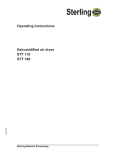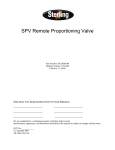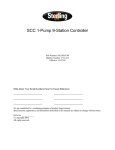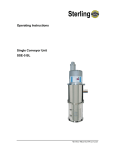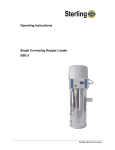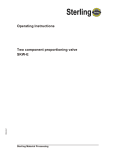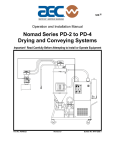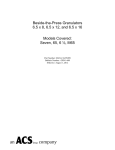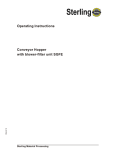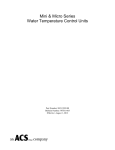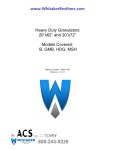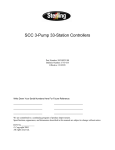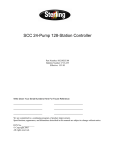Download Sterling SSC1-5Q Marine Battery User Manual
Transcript
$3000 SSC1-5Q Conveying Systems 1-Pump 5-Station Controller Operation, Installation, and Service Manual Sterling 5200 W. Clinton Ave Milwaukee, WI 53223 Tel. (414) 354-0970 Fax (414) 354-6421 www.sterlco.com Part No. A0 Bulletin No. SM2-615 11/7/03 Please note that our address and phone information has changed. Please reference this page for updated contact information. These manuals are obsolete and are provided only for their technical information, data and capacities. Portions of these manuals detailing procedures or precautions in the operation, inspection, maintenance and repair of the products may be inadequate, inaccurate, and/or incomplete and shouldn’t be relied upon. Please contact the ACS Group for more current information about these manuals and their warnings and precautions. Parts and Service Department The ACS Customer Service Group will provide your company with genuine OEM quality parts manufactured to engineering design specifications, which will maximize your equipment’s performance and efficiency. To assist in expediting your phone or fax order, please have the model and serial number of your unit when you contact us. A customer replacement parts list is included in this manual for your convenience. ACS welcomes inquiries on all your parts needs and is dedicated to providing excellent customer service. For immediate assistance, please contact: • North, Central and South America, 8am – 5pm CST +1 (800) 483-3919 for drying, conveying, heating and cooling and automation. For size reduction: +1 (800) 229-2919. North America, emergencies after 5pm CST (847) 439-5855 North America email: [email protected] • Mexico, Central & South America Email: [email protected] • Europe, Middle East & Africa +48 22 390 9720 Email: [email protected] • India +91 21 35329112 Email: [email protected] • Asia/Australia +86 512 8717 1919 Email: [email protected] Sales and Contracting Department Our products are sold by a worldwide network of independent sales representatives. Contact our Sales Department for the name of the sales representative nearest you. Let us install your system. The Contract Department offers any or all of these services: project planning; system packages including drawings; equipment, labor, and construction materials; and union or non-union installations. For assistance with your sales or system contracting needs please Call: North, Central and South America +1 (262) 641-8600 or +1 (847) 273-7700 Monday–Friday, 8am–5pm CST Europe/Middle East/Africa +48 22 390 9720 India +91 21 35329112 Asia/Australia +86 512 8717 1919 Facilities: ACS offers facilities around the world to service you no matter where you are located. For more information, please visit us at www.acscorporate.com United States: ACS Schaumburg – Corporate Offices 1100 E. Woodfield Road Suite 588 Schaumburg, IL 60173 Phone: + 1 847 273 7700 Fax: + 1 847 273 7804 ACS New Berlin – Manufacturing Facility th 2900 S. 160 Street New Berlin, WI 53151 Phone : +1 262 641 8600 Fax: + 1 262 641 8653 Asia/Australia: ACS Suzhou 109 Xingpu Road SIP Suzhou, China 215126 Phone: + 86 8717 1919 Fax: +86 512 8717 1916 Europe/Middle East/Africa: ACS Warsaw Ul. Działkowa 115 02-234 Warszawa Phone: + 48 22 390 9720 Fax: +48 22 390 9724 India ACS India Gat No. 191/1, Sandbhor Complex Mhalunge, Chakan, Tal Khed, Dist. Pune 410501, India Phone: +91 21 35329112 Fax: + 91 20 40147576 Write down your unit serial number(s) here for future reference Model # Serial # ________________ ________________ ________________ ________________ ________________ ________________ ________________ ________________ Performance figures stated in this manual are based on a standard atmosphere of 59°F (15°C) at 29.92” Hg (1,014 millibars) at sea level, using 60 Hz power. Altitude is an important consideration when specifying vacuum conveying components. Sterling can advise you on proper selection and sizing of systems for your operating environment. Sterling is committed to a continuing program of product improvement. Specifications, appearance, and dimensions described in this manual are subject to change without notice. © Copyright Sterling 2003 All rights reserved. Part No. A0 Effective 11/7/2003 Bulletin No. SM2-615 Page ii of 38 Table of Contents 1 General Information......................................................................... 8 1-1 1-2 1-3 1-4 1-5 2 Safety ............................................................................................... 11 2-1 2-2 2-3 2-4 2-5 2-6 2-7 3 Work Rules .................................................................................................11 Tools and Equipment Needed ....................................................................11 Safety Considerations ................................................................................11 2-3-1 Reporting a Safety Defect ..............................................................12 General Responsibility................................................................................12 Operator Responsibility ..............................................................................13 Maintenance Responsibility........................................................................13 Safety Devices............................................................................................14 2-7-1 Safety Circuit Standards.................................................................14 2-7-2 Fail Safe Operation ........................................................................14 2-7-3 Safety Device Lock-Outs................................................................15 Shipping Information...................................................................... 17 3-1 3-2 3-3 3-4 3-5 3-6 3-7 4 Equipment Function......................................................................................8 Necessary Documents .................................................................................8 System Capabilities ......................................................................................8 Equipment Cycle ..........................................................................................9 Models Covered by this Manual ...................................................................9 Unpacking and Inspection ..........................................................................17 In the Event of Shipping Damages .............................................................17 Parcel Post Shipment .................................................................................17 United Parcel Service Shipment.................................................................18 If the Shipment is Not Complete.................................................................18 If the Shipment is Not Correct ....................................................................18 Returns .......................................................................................................18 Installation....................................................................................... 19 4-1 4-2 4-3 4-4 4-5 Installing the VacTrac Control Panel ..........................................................19 Making Electrical Connections ...................................................................19 Making SSC1-5Q Control Panel Power Drop Wiring Connections ............19 Connecting the Control Panel to Vacuum Receivers .................................19 Connecting the Control Panel to the Pump Package .................................20 Page iii of 38 Table of Contents 5 Using the Controller ....................................................................... 21 5-1 5-2 Introduction.................................................................................................21 Setup ..........................................................................................................21 5-2-1 Setting Up the System....................................................................21 5-2-1-1-1 5-2-1-1-2 5-2-1-1-3 5-2-1-1-4 Setting Pump Parameters...................................................... 22 Setting Blowback Parameters ................................................ 22 Input and Output Screen Features......................................... 23 Changing Parameters ............................................................ 23 5-2-2 Starting the System ........................................................................23 6 Configurable Settings..................................................................... 25 6-1 6-2 7 8 Options for Station Setup ...........................................................................25 Options for Pump Setup .............................................................................26 Maintenance ................................................................................... 27 Troubleshooting ............................................................................ 28 8-1 8-2 General Troubleshooting ............................................................................28 Alarms ........................................................................................................29 8-2-1 Station Alarms ................................................................................29 8-2-2 Pump Alarms..................................................................................29 9 Options ............................................................................................ 30 10 Spare Parts List .............................................................................. 31 10-1 Recommended Spare Parts List.................................................................31 11 Technical Assistance ..................................................................... 32 11-1 Contact Information for Technical Assistance ............................................32 11-2 Returned Material Policy ............................................................................33 11-2-1 Credit Returns ................................................................................33 11-2-2 Warranty Returns ...........................................................................33 11-3 Warranty .....................................................................................................34 12 Safety Tag Information ................................................................... 35 12-1 Controller Safety Tags................................................................................35 12-2 Controller Identification (Serial Number) Tag .............................................35 13 Appendix ......................................................................................... 36 Page iv of 38 Charts and Figures 1 SSC1-5Q Controller ............................................................................................. 10 Page v of 38 Safety Considerations Sterling conveying systems are designed to provide safe and reliable operation when installed and operated within design specifications, following national and local safety codes. To avoid possible personnel injury or equipment damage when installing or operating this equipment, always use good judgment and follow these safe practices: ; Follow all SAFETY CODES. ; Wear SAFETY GLASSES and WORK GLOVES. ; Use care when LOADING, UNLOADING, RIGGING, or MOVING this equipment. ; OPEN, TAG, and LOCK ALL DISCONNECTS before working on equipment. It is a good idea to remove the fuses and carry them with you. ; GROUND your conveying system properly before applying power. ; Use extreme caution when working with your Sterling conveying system. HIGH VACUUM can be dangerous. Keep body parts, tools, clothing, and debris away from vacuum inlets. ; Do not jump or bypass any electrical safety control. ; Do not restore power until you remove all tools, test equipment, etc. ; Only PROPERLY TRAINED personnel familiar with the information in this manual should work on this equipment. Sterling “SSC1-5Q” Conveying Systems 1-Pump 5-Station Controller This controller is manufactured by ACS, Inc. at the ACS-Wood Dale facility: ACS, Inc. 801 Wood Dale Rd. Wood Dale, IL 60191 Phone: 630.595.1060 Fax: 630.595.6641 The equipment is distributed in Europe by our European Facility: ACS-EUROPE Daniels Industrial Estate BATH ROAD Stroud, Gloucestershire, England GL5 3TJ Phone: (44) 1453 768980 Fax: (44) 1453 768990 Page 7 of 38 1 General Information 1-1 Equipment Function Sterling systems create vacuum for conveying pelletized or granular material in a central material handling system. A typical use is an in-plant distribution system for plastic processing plants. 1-2 Necessary Documents The documents below are necessary for proper installation, operation and maintenance of conveying systems. You can obtain additional copies from the Service Department at Sterling. Make sure that the appropriate personnel are familiar with these documents: • This product manual. • The Sterling SPD/SPC Series product manual. • Electrical schematic and connection diagrams. • Blower and electric motor information sheets. • Operation and Installation manuals for all electrical components. 1-3 System Capabilities Sterling central vacuum systems are as varied as the applications they service. The tubing and equipment furnished in a Sterling system are designed to convey the material(s) specified at the time of purchase at specific rates and distances. Sterling can advise you on your system capabilities based on system makeup, distance, material, and conveying rates you want. System capacity is directly affected by the pressure drop in the overall system, such as number of material line bends, pipe length, Y-tubes, T-tubes, etc. Page 8 of 38 Use the minimum effective amount of vinyl flex hose to maximize material line efficiency. Keep material lines as straight as possible. Refer to the Sterling SPD/SPC Series Product Manual (Sterling Part No. A0571050) for installation recommendations. Important! Vacuum leaks occurring anywhere in your system reduce capacity. 1-4 Equipment Cycle Sterling material conveying systems are used for automatic pneumatic handling of most free-flowing, dry, pelletized, or granular materials. Material characteristics determine the type of equipment needed to convey the material. 1-5 Models Covered by this Manual SSC1-5Q 5-Station Controller • Programmable Logic Controller. • 24 VDC control circuits. • Easy-to-use operator interface. • Audible/visual alarm. Page 9 of 38 Figure 1: SSC1-5Q Controller 16” 6.35” 6” Display 2.0” 16” * Depth dimension is 12” Page 10 of 38 2 Safety 2-1 Work Rules The installation, operation, and maintenance of this equipment must be conducted in accordance with all applicable work and safety codes for the installation location. This may include, but is not limited to OSHA, NEC, CSA, SPI, and any other local, national, and international regulations. ; Read and follow these operating instructions when installing, operating, and maintaining this equipment. If the instructions become damaged or unreadable, additional copies are available from Sterling. ; Only qualified personnel familiar with this equipment should work with this system. ; Work only with approved tools and devices. ; Disconnect and lock out power while working on this equipment. 2-2 Tools and Equipment Needed These tools and equipment are necessary for installation: ; Hand tools. ; Wire, conduit, and fittings for wiring runs. ; Anchor bolts with nuts and washers or red head-type anchors. 2-3 Safety Considerations The terms NOTICE, CAUTION, WARNING, and DANGER have specific meanings in this manual. NOTICE is used to indicate a statement of company policy directly or indirectly related to the safety of personnel or protection of property. CAUTION indicates a potentially hazardous situation which, if not avoided, may result in minor injury. WARNING indicates a potentially hazardous situation which, if not avoided, could result in death or serious injury. Page 11 of 38 DANGER indicates an imminently hazardous situation which, if not avoided, will result in death or serious injury. This word will be limited to the most serious situations. The term IMPORTANT emphasizes areas where equipment damage could result, or provides additional information to make a step or procedure easier to understand. Disregarding information marked IMPORTANT would not be likely to cause personal injury. 2-3-1 Reporting a Safety Defect If you believe that your equipment has a defect that could cause injury, you should immediately discontinue its use and inform Sterling. The principle factors that can result in injury are failure to follow proper operating procedures (i.e. lockout/tagout), or failure to maintain a clean and safe working environment. 2-4 General Responsibility No mater who you are, safety is important. Owners, operators and maintenance personnel must realize that every day, safety is a vital part of their jobs. If your main concern is loss of productivity, remember that production is always affected in a negative way following an accident. The following are some of the ways that accidents can affect your production: • Loss of a skilled operator (temporarily or permanently) • Breakdown of shop morale • Costly damage to equipment • Downtime An effective safety program is responsible and economically sound. Organize a safety committee or group, and hold regular meetings. Promote this group from the management level. Through this group, the safety program can be continually reviewed, maintained, and improved. Keep minutes or a record of the meetings. Page 12 of 38 Hold daily equipment inspections in addition to regular maintenance checks. You will keep your equipment safe for production and exhibit your commitment to safety. Please read and use this manual as a guide to equipment safety. This manual contains safety warnings throughout, specific to each function and point of operation. 2-5 Operator Responsibility The operator’s responsibility does not end with efficient production. The operator usually has the most daily contact with the equipment and intimately knows its capabilities and limitations. Plant and personnel safety is sometimes forgotten in the desire to meet incentive rates, or through a casual attitude toward machinery formed over a period of months or years. Your employer probably has established a set of safety rules in your workplace. Those rules, this manual, or any other safety information will not keep you from being injured while operating your equipment. Learn and always use safe operation. Cooperate with coworkers to promote safe practices. Immediately report any potentially dangerous situation to your supervisor or appropriate person. 2-6 Maintenance Responsibility Proper maintenance is essential to safety. If you are a maintenance worker, you must make safety a priority to effectively repair and maintain equipment. Before removing, adjusting, or replacing parts on a machine, remember to turn off all electric supplies and all accessory equipment at the machine, and disconnect and lockout electrical power. Attach warning tags to the disconnect switch. Be sure that all non-current carrying parts are correctly connected to earth ground with an electrical conductor that complies with current codes. Install in accordance with national and local codes. When you have completed the repair or maintenance procedure, check your work, remove your tools. Rigging, and handling equipment. Page 13 of 38 2-7 Safety Devices This section includes information on safety devices and procedures that are inherent to the SSC1-5Q Controller. This manual is not intended to supersede or alter safety standards established by the user of this equipment. Instead, the material contained in this section is recommended to supplement these procedures in order to provide a safer working environment. At the completion of this section, the operator and maintenance personnel will be able to do the following: • Identify and locate specific safety devices. • Understand the proper use of the safety devices provided. • Describe the function of the safety device. 2-7-1 Safety Circuit Standards Safety circuits used in industrial systems protect the operator and maintenance personnel from dangerous energy. They also provide a means of locking out or isolating the energy for servicing equipment. Various agencies have contributed to the establishment of safety standards that apply to the design and manufacture of automated equipment. The Occupational Safety and Health Administration (OSHA) and the Joint Industrial council (JIC) are just a few of the organizations that have joined with the plastics industry to develop safety standards. Every effort has been made to incorporate these standards into the design of the SPD/SPC system; however, it is the responsibility of the personnel operating and maintaining the equipment to familiarize themselves with the safety procedures and the proper use of any safety devices. 2-7-2 Fail Safe Operation If a safety device or circuit should fail, the design must be such that the failure causes a “Safe” condition. As an example, a safety switch must be a normally open switch. The switch must be held closed with the device it is to protect. If the switch fails, it will go to the open condition, tripping out the safety circuit. At no time should the safety device fail and allow the operation to continue for example, if a safety switch is Page 14 of 38 guarding a motor, and the safety switch fails, the motor should not be able to run. 2-7-3 Safety Device Lock-Outs Some safety devices disconnect electrical energy from a circuit. The safety devices that are used in the SSC1-5Q Controller are primarily concerned with electrical power disconnection. WARNING! Always disconnect and lockout all electrical power and pneumatic (i.e. compressed air) sources prior to servicing the SSC1-5Q Controller. Failure to do so may result in serious injury. No one but the person who installed the lockout may remove it. Page 15 of 38 -Notes- Page 16 of 38 3 Shipping Information 3-1 Unpacking and Inspection You should inspect your Sterling SSC1-5Q 5-station controller for any possible shipping damage. If the container and packing materials are in re-usable condition, save them for reshipment if necessary. Thoroughly check the equipment for any damage that might have occurred in transit, such as broken or loose wiring and components, loose hardware and mounting screws, etc. In case of breakage, damage, shortage, or incorrect shipment, refer to the following sections. 3-2 In the Event of Shipping Damages Important! According to the contract terms and conditions of the Carrier, the responsibility of the Shipper ends at the time and place of shipment. ; Notify the transportation company’s local agent if you discover damage. ; Hold the damaged goods and packing material for the examining agent’s inspection. Do not return any goods to Sterling before the transportation company inspection and authorization. ; File a claim against the transportation company. Substantiate the claim by referring to the agent’s report. A certified copy of our invoice is available upon request. The original Bill of Lading is attached to our original invoice. If the shipment was prepaid, write us for a receipted transportation bill. ; Advise Sterling regarding your wish for assistance and to obtain an RMA (return material authorization) number. 3-3 Parcel Post Shipment Notify Sterling at once in writing, giving details of the loss or damage. This information is required for filing a claim with our insurance company. Page 17 of 38 Hold the damaged goods with the container and packing materials for possible inspection by postal authorities. 3-4 United Parcel Service Shipment ; Contact your local UPS office regarding damage and insurance claims. ; Retain the container and packing. ; Notify Sterling at once. 3-5 If the Shipment is Not Complete Check the packing list. The apparent shortage may be intentional. Back-ordered items are noted on the packing list. You should have: ; Sterling SSC1-5Q 5-station controller ; Bill of Lading ; Packing list ; Operating and Installation packet ; Electrical schematic and panel layout drawings ; Component instruction manuals Re-inspect the container and packing material to see if you missed any smaller items during unpacking. Determine that the item was not inadvertently taken from the area before you checked in the shipment. Notify Sterling immediately of the shortage. 3-6 If the Shipment is Not Correct If the shipment is not what you ordered, contact Sterling immediately. For shipments in the United States and Canada, call 1 (414) 354-0970; for all other countries, call 001 (414) 354-0970. Include the order number and item. Hold the items until you receive shipping instructions. 3-7 Returns Important! Do not return any damaged or incorrect items until you receive shipping instructions from Sterling. Page 18 of 38 4 Installation 4-1 Installing the SCC1-5Q Control Panel Note: Before you mount the panel, consider how you run wiring to the vacuum receivers, the filter chamber atmospheric valve (if so equipped) and the pump motor starter(s), vacuum switch(es), and vent valve(s). Mount the panel on a flat, vertical area. It should be a visible area that gives your operator access to the control. The panel requires a low voltage power drop as listed on the serial tag. 4-2 Making Electrical Connections Refer to local electrical codes, the schematic and connection diagrams supplied with this unit and the serial tag for wiring considerations. Run all wiring in conduit if codes require it. 4-3 Making SSC1-5Q Control Panel Power Drop Wiring Connections Hardwire the input power at 110/1/50-60 VAC or 230V/1/5060 VAC, depending on the specifications, which are located on the SSC1-5Q Control Panel Serial Tag. The main power switch is located on the right side of the enclosure. Important! Sterling recommends that you protect PLC memory by providing the control panel with a dedicated circuit, a true earth ground, and a spike/surge protector. 4-4 Connecting the Control Panel to Vacuum Receivers 1. On 24 VDC control voltage systems, run a common +24 VDC wire and a common 0 (zero) VDC wire from the controller to each vacuum receiver in the SSC system. 2. On all systems, run two wires to each vacuum receiver: one each from the controller to the Bin-Full switch (LS) and to the Atmospheric/Sequence-T solenoid (SOL) valve. 3. Make sure that the solenoid and the proximity switch (if supplied) on vacuum receivers are the same voltage (24 Page 19 of 38 VDC) as the SSC control panel voltage. Consult the control panel serial tag and the solenoid valve nameplates. 4. Wire size depends on control voltage, distance, number of vacuum receivers, and the number of wires in each raceway. Consult a qualified electrician. 5. Properly ground each receiver to reduce static build up generated by material conveying. 4-5 Connecting the Control Panel to the Pump Package 1. Wire the pump package motor starter coil (M) to the terminal provided in the SSC control panel enclosure. 2. Wire the pump package vacuum relief valve solenoid (SOL A) to the terminal provided in the SSC control panel enclosure. 3. Wire the pump package vacuum switch (VS) to the terminal located in the SSC control panel enclosure (If provided). 4. On SPDB pumps, wire the pump package blowback solenoid (SOL B) to the terminal located in the SSC control panel enclosure. Wire the pump package motor overload to the terminal provided in the SSC control panel enclosure. 5. On 24 VDC control voltage systems, run a common +24 VDC wire and a common 0 (zero) VDC wire from the controller to each pump package in the conveying system. 4-6 Special Timed Convey Connect +24 VDC to inputs 11-15, corresponding to Stations 1-5, to enable the Special Timed Convey feature. Page 20 of 38 5 Using the Controller 5-1 Introduction This chapter gives the procedures for configuring your SSC1-5Q controller. Configuration of your SSC1-50Q controller includes setting the number of stations, setting variables such as convey time and blow-back interval. Sterling recommends that you carry out these procedures in the order given here. 5-2 Setup Important! Before carrying out these procedures, install all equipment as described in Chapter 4: “Installation”, and in the manual SPD/SPC Series Conveying Systems. 5-2-1 Setting Up the System This section provides an overview of the controller screens used in configuring the system. Section 6 provides a detailed explanation of the features listed on each screen. 5-2-1-1 Basic Menus and Setup of Controller Once power has been applied to a properly installed system, turn the disconnect switch to the ON position. The alpha controller will display the screen for receiver 1 (Hopper 1). Page 21 of 38 This screen allows the operator to adjust the convey time (CONVEY), dump delay (DUMP), and the number of tries before the no convy alarm activates (NO CONVEY). To disable a station, set the convey time to 0 (zero). Important! DO NOT set the Dump delay or No Convey to 0 (zero). To set the parameters for each receiver, use the left (◄) or right (►) arrow keys to scroll through the settings for the next (►) or previous (◄) receiver. 5-2-1-1-1 Setting Pump Parameters To access the pump screen, press the right arrow key (►) when in the station 5 screen or press the left arrow key (◄) when in the blowback screen. This screen allows the operator to adjust the pump motor ramp up/ramp down time (RAMP) and the amount of time the pump runs unloaded before shutting off (IDLE). Important! DO NOT set the Idle Time or Ramp time to 0 (Zero). 5-2-1-1-2 Setting Blowback Parameters Once the pump parameters have been set, the blowback parameters will need to be configured. This screen can be accessed for each station, by pressing the right arrow key (►) when in the pump parameters screen (RAMP and IDLE times are displayed). This screen allows the operator to adjust all those settings related to cleaning the filter chamber: the number of conveys before blowback (CNV>BB), the duration between blowback pules (BB OFF), the duration of the pulse (BB ON), and the number of cleaning pulses (BB CYC). Page 22 of 38 Important! Setting either the CNV>BB or BB CYC parameters to “0” will disable the blowback feature. DO NOT set other blowback parameters to “0.” 5-2-1-1-3 Input and Output Screen Features To access the I/O screen, press the right arrow key (►) when the Blowback Parameter screen is displayed or the left arrow key (◄) when the Convey/Dump/No Convey screen is displayed. The I/O screen allows a service technician to view the status of the controller’s inputs and outputs during operation. 5-2-1-1-4 Changing Parameters To change the settings in the Conveying, Pump Parameters, or Blowback screens {To access the required screen, press the right (►) or the left arrow key (◄)}, the following operations will need to be performed: 1. When the controller is in the menu screen of the feature you wish to configure, press the up (▲) and down (▼) arrow keys to select the value you wish to change. (The parameter value will flash when selected.) 2. Use the Plus (+) key to increase the value or the Minus (-) key to decrease the value. 3. Press the OK key to update and accept the new value entered. 4. Press the ESC key to cancel the parameters you entered and return the values to the previous settings. 5-2-2 Starting the System Once you have finished the setup procedues described on the previous pages, you are now ready to start the system. To start your system, complete the following steps. Page 23 of 38 1. Press the green START pushbutton in. The controller will display “✷✷✷” in the lower right corner of station and pump setup screens. Once the system has been started, each active station is polled in sequence for a demand signal. The convey sequence upon initiation, will continue until the set convey time has elapsed or the demand signal stops, whichever happens first. If the Special Timed Convey feature is enabled, conveying will continue until the convey time has elapsed. (Once station dump delay has been initiated during the convey sequence, a new demand signal will be ignored.) If the blowback sequence begins immediately following the convey sequence, the sequence valve will remain open throughout the blowback sequence. 2. If during operation, a station conveys the specified number of consecutive times without clearing the demand signal, the NO CONVEY alarm will activate. Press the ALARM SILENCE pushbutton and hold it in to clear the alarm. The no convey alarm will sound in LONG TONES. 3. Should the high vacuum pressure switch activate, the HIGH VACUUM alarm will sound. Press the ALARM SILENCE pushbutton and hold it in to clear the alarm. The high vaccum alarm will sound in SHORT TONES. 4. If the pump motor contactor fails or the pump motor overload trips, the PUMP FAULT alarm will be activated. Press the ALARM SILENCE pushbutton and hold it in to clear the alarm. The pump fault alarm will sound in a CONTINUOUS TONE. 5. To stop conveying, depress the green START pushbutton. The controller will no longer display “✷✷✷” on the station and pump setup screens. Page 24 of 38 6 Configurable Settings This section describes the proper setup of the SSC1-5Q control system parameters. These parameters are operator changeable; however, these items should require setup only during the initial installation. Only authorized personnel should change them. Many of the variables and setup parameters have been preset at the factory and do not need to be changed. However, this section of the manual will address all of the setup parameters that were available at the time of printing. The purpose of this is to familiarize the reader with all the setup parameters and their usage. 6-1 Options for Station Setup Name Description Conveying Components Convey time Length of time the station’s vacuum valve remains open to (CONVEY) allow material to be drawn in. (For a volume-fill station, the valve closes when material covers the station’s volume-fill proximity sensor or this time elapses, whichever comes first.) Dump delay (DUMP) No convey (NO CONVEY) Adjust this value to match the actual time needed to fill the station. To disable a station, set the convey time to Ø (zero). Length of time allowed for material to drain from the station into the receiver. The controller will not attempt to deliver more material to the station until this time has elapsed. Adjust this value to match the actual time needed to drain the station. If it is set too short, the controller may attempt to refill the station before it is empty, causing material to back up and/or underusing the station’s capacity. If it is set too long, the system may be unable to keep up with your equipment’s demand for material. DO NOT SET TO “Ø”. The controller issues a “no convey” alarm if it has repeatedly attempted to convey material to the station but the flapper never opened during the dump delay. (The number of attempts is controlled by this setting.) The setting for this option depends on (a) how much material your injection mold uses to make each part compared with the capacity of the receiver and (b) how important it is to keep your injection mold from running out of material and shutting down. A higher setting will give you fewer alarms, at the risk of emptying the receiver without warning. A lower setting will give more frequent alarms, at the risk of disrupting operations unnecessarily. DO NOT SET TO “Ø”. Page 25 of 38 Default 15 sec. 10 sec. 3 6-2 Options for Pump Setup The ramp time represents the amount of time it takes for the vacuum blower to come up to full speed once it has been turned on. The ramp down time represents the amount of time it takes the blower to stop once it has been turned off. The ramp up time lets the blower reach full speed unloaded. When the ramp up time is reached, the vent valve will open and allow the pump to draw a vacuum on the main vacuum line. This in turn will open the receiver sequence valve connected to the main vacuum line and allow material to be drawn into the vacuum receiver. The ramp down time allows the vacuum blower to come to a full stop before it can be started again. This prevents the blower motor from becoming a generator and blowing fuses. Name Pump Settings Idle (IDLE) Ramp Up Ramp Down (Ramp Dn) Conveys Before Blowback (CNV>BB) Pulse On Time (BB ON) Description Default Length of time the pump continues to run unloaded without demand from any station. After this time has elapsed, the pump shuts down to save power and to prevent wear on the pump. Adjust this setting to fit the needs of your facility in trading off the savings against the costs associated with waiting for a pump to start up when there is a demand for material. This feature specifies the time (in seconds) allowed for the pump motor to reach operating speed. This feature specifies the time (in seconds) allowed for the pump motor to come to a complete stop. When this option is enabled, the controller periodically sends compressed air backward through the pump’s air filter to dislodge accumulated dust and debris. Enable this option if and only if the pump has the equipment for compressed-air filter cleaning. Set to Ø to Disable Blowback. Number of conveying cycles to stations between filter cleanings. Adjust this setting based on experience. The more dust and debris in your material line, the smaller this number needs to be. Tenths of seconds that the air pulse remains on for each cleaning pulse during filter cleaning. If blow-back is not working as desired, the Sterling service may ask you to change this setting. 45 sec. 5 sec. 5 sec. enabled 5 1.6 sec. Pulse Off time (BB OFF) Tenths of seconds between air pulses during filter cleaning. If blow-back is not working as desired, the Sterling service may ask you to change this setting. 0.8 sec. Numbler of cleaning pulses (No. Pulses) (BB CYC) Number of pulses of compressed air sent through the pump’s filter during cleaning. If blow-back is not working as desired, the Sterling service may ask you to change this setting. Set to Ø to Disable Blowback. 1 Page 26 of 38 7 Maintenance No Periodic maintenance is required on this unit. Page 27 of 38 8 Troubleshooting 8-1 General Troubleshooting Problem The control panel doesn’t light up at all A pump package doesn’t run, even though it is on-line and its indicator is lit. A vacuum receiver is being bypassed in the loading cycle. Vacuum receivers are overfilling. Possible Cause The control panel is not turned on. Solution Turn on the control panel. The external disconnect (recommended) in the dedicated circuit is open (off). Fuse/circuit breaker in the power drop is blown/tripped. Control power switch is broken. The motor overload has tripped. Close the switch (on). Main fuse in power drop or optional fused disconnect has blown. Motor contact is faulty. The vacuum receiver is off-line. The convey time for the vacuum receiver is set to zero. The field-installed station bypass switch is simulating a Bin Full condition. The field-installed station bypass switch is bad or mis-wired. The vacuum receiver was assigned to the wrong pump during setup. Conveying times are too long (Time Fill Mode only). Maximum conveying times are too long, and the PLC does not recognize the Vacuum Receiver Full Proximity Switch(es). Page 28 of 38 Replace/reset. Replace. Reset the overload and check the motor for the proper amp draw on tag. Replace the fuse. Repair or replace as required. Use the controller to put the vacuum receiver on-line. Use the controller to enter a longer convey time. Normal operation. Set the switch so the vacuum receiver is back in the loading sequence. Repair, replace, or re-wire. Repeat the setup procedure. Time the vacuum receiver (s) during loading, and set the conveying times to a few seconds less. Check proximity sensors for proper operation and proper wiring to the PLC. Repair as needed. Reset the conveying times to a reasonable value, and adjust as needed. 8-2 Alarms The format for all station alarms is “Station n [alarm text],” for example, “Station 12 receiver low level.” The format for all pump alarms is “Pump n [alarm text].” Any alarm that does not start with “Station” or “Pump” is a system alarm. The following tables list all alarms alphabetically, together with possible causes. A “critical” alarm is one that causes the affected device to stop. Note: You can also see a list of alarms and their causes in the controller’s online help. To display this information, touch the color key of statuses in the upper right-hand corner of either the “Station Status” or the “Pump Status” screen, or touch Help at any other screen. When you are finished reviewing the help, touch Return. 8-2-1 Station Alarms Alarm message High vacuum No convey Possible cause Material line is blocked. Vacuum line is blocked. Convey time is too long (time-fill station only). Sequence valve has malfunctioned. Vacuum switch has malfunctioned. Note: After you have corrected the cause of this alarm, the alarm will be cleared when the controller has conveyed a full load to this station. Material container is empty. Material line is disconnected from material source. Vacuum line is disconnected from station. Take-off compartment is not adjusted properly. Convey time is too short. Note: As a stopgap measure, you can disable the “no convey” alarm for this station until the problem can be remedied. 8-2-2 Pump Alarms Alarm message Pump failure (Critical) Possible cause Circuit breaker or overload protector has tripped. Contactor has malfunctioned. Page 29 of 38 9 Options The following is a list of options that your controller may be equipped with: 230/1/60 Operation Required to operate with a 230/1/60 supply voltage. CE Package for 220/1/50 Operation Required in Europe and other areas that need 220/1/50 supply voltage Remote Audible/visual alarm Alarm light and horn assembly that can be remote mounted and wired into the controller to indicate an alarm condition. Page 30 of 38 10 Spare Parts List 10-1 Recommended Spare Parts List Quantity 1 1 Sterling Part Number A0538007 A0536896 Vendor Part Number FNM-6 FNM-2 Page 31 of 38 Description Fuse Fuse 11 Technical Assistance 11-1 Contact Information for Technical Assistance Parts Department Call toll-free 7am–5pm CST [800] 423-3183 or call [414] 354-0970, Fax [414] 354-6421 The ACS Customer Service Group will provide your company with genuine OEM quality parts manufactured to Sterling engineering design specifications, which will maximize your equipment’s performance and efficiency. To assist in expediting your phone or fax order, please have the model and serial number of your unit when you contact us. A customer replacement parts list is included in this manual for your convenience. ACS welcomes inquiries on all your Sterling parts needs and is dedicated to providing excellent customer service. Service Department Call toll-free 8am–5pm CST [800] 657-4679 or call [414] 354-0970 Emergencies after 5pm CST, call [847] 439-5655 Sterling has a qualified service department ready to help. Service contracts are available for most Sterling products. Sales Department Call [414] 354-0970 Monday–Friday, 8am–5pm CST Sterling products are sold by a world-wide network of independent sales representatives. Contact our Sales Department for the name of the sales representative nearest you. Contract Department Call [414] 354-0970 Monday–Friday, 8am–5pm CST Let Sterling install your system. The Contract Department offers any or all of these services: project planning; system packages including drawings; equipment, labor, and construction materials; and union or non-union installations. Sterling 5200 W. Clinton Ave Milwaukee, WI 53223 [414] 354-0970 • Fax [414] 354-6421 Page 32 of 38 11-2 Returned Material Policy 11-2-1 Credit Returns 1. Prior to the return of any material, authorization must be given by Sterling. A RMS number will be assigned for the equipment to be returned. 2. Reason for requesting the return must be given. 3. All returned material purchased from Sterling returned is subject to 15% ($75.00 minimum) restocking charge. 4. All returns are to be shipped prepaid. 5. The invoice number and date or purchase order number and date must be supplied. 6. No credit will be issued for material that is not within the manufacturer’s warranty period and/or in new and unused condition, suitable for resale. 11-2-2 Warranty Returns 1. Prior to the return of any material, authorization must be given by Sterling. A RMS number will be assigned for the equipment to be returned. 2. Reason for requesting the return must be given. 3. All returns are to be shipped prepaid. 4. The invoice number and date or purchase order number and date must be supplied. 5. After inspecting the material, a replacement or credit will be given, at Sterling’s discretion, if the item is found to be defective in materials or workmanship, and it was manufactured by Sterling. Purchased components are covered under their specific warranty terms. Page 33 of 38 11-3 Warranty Sterling warrants all equipment manufactured by it to be free from defects in workmanship and material when used under recommended conditions. The Company’s obligation is limited to repair or replace FOB the factory any parts that are returned prepaid within one year of equipment shipment to the original purchaser, and which, in the Company’s opinion, are defective. Any replacement part assumes the unused portion of this warranty. This parts warranty does not cover any labor charges for replacement of parts, adjustment repairs, or any other work. This warranty does not apply to any equipment which, in the Company’s opinion, has been subjected to misuse, negligence, or operation in excess of recommended limits, including freezing or which has been repaired or altered without the Company’s express authorization. If the serial number has been defaced or removed from the component, the warranty on that component is void. Defective parts become the property of the warrantor and are to be returned. The Company is not liable for any incidental, consequential, or special damages or expense. The Company’s obligation for parts not furnished as components of its manufactured equipment is limited to the warranty of the manufacturers of said parts. Any sales, use, excise, or other tax incident to the replacement of parts under this warranty is the responsibility of the purchaser. The company neither assumes nor authorizes any other persons to assume for it any liability in connection with the sale of its equipment not expressed in this warranty. Page 34 of 38 12 Safety Tag Information 12-1 Controller Safety Tags High Voltage Inside Enclosure Read Operation and Installation Manual 12-2 Controller Identification (Serial Number) Tag (Located on the side of the controller box) 5200 W. Clinton Ave Milwaukee, WI 53223 Tel. (414) 354-0970 Fax (414) 354-6421 SSC CONTROL PANEL Model No. SSC1-5Q 115 Volt 60 Serial No. 31K0182 Hz Control Voltage 24VDC Page 35 of 38 1 Ph 13 Appendix Review electrical drawings supplied in the packet with the manual. Page 36 of 38 Sterling warrants all equipment manufactured by it to be free from defects in workmanship and material when used under recommended conditions. The Company’s obligation is limited to repair or replace FOB the factory any parts that are returned prepaid within one (1) year of equipment shipment to the original purchaser, and which, in the Company’s opinion, are defective. Any replacement part assumes the unused portion of this warranty. This warranty does not apply to any equipment which, in the Company’s opinion, has subjected to misuse, negligence, or operation in excess of recommended limits or which has repaired or altered without the Company’s express authorization. If the serial number has defaced or removed from the component, the warranty on that component is void. Defective become the property of the warrantor and are to be returned. been been been parts The Company is not liable for any incidental, consequential, or special damages or expenses. The Company’s obligation for parts not furnished as components of its manufactured equipment is limited to the warranty of the manufacturers of said parts. Any sales, use, excise, or other tax incident to the replacement of parts under this warranty is the responsibility of the purchaser. The company neither assumes nor authorizes any other persons to assume for it any liability in connection with the sale of its equipment not expressed in this warranty. Many types of Sterling equipment carry an additional one-year service policy. Consult your Sterling/Sterlco sales representative for specific details. PO Box 245018 • 5200 W. Clinton Avenue • Milwaukee, WI 53224-9518 USA Phone (414) 354-0970 • Fax (414) 354-6421 http://www.sterlco.com Service Department Call Toll Free (800) 783-7835 Auxiliary Equipment for the Process Industries PO Box 245018 5200 West Clinton Avenue • Milwaukee, WI 53224-9518 (414) 354-0970 • Fax (414) 354-6421 Scrap Recovery Systems Process Heating/ Cooling Automated Parts Removal Material Processing







































